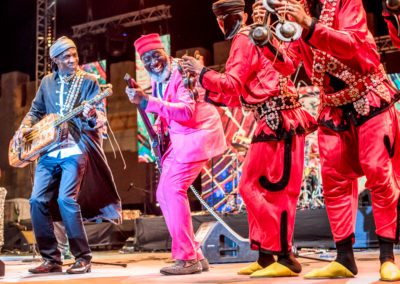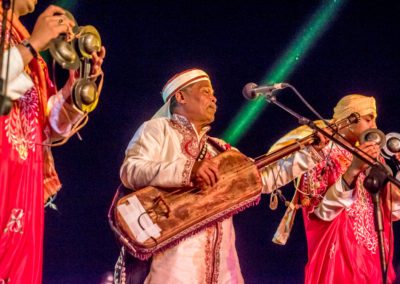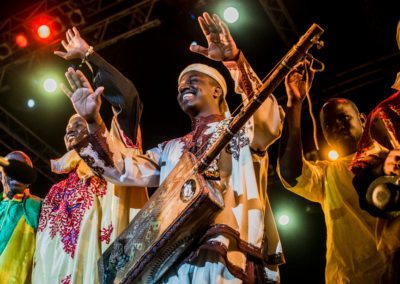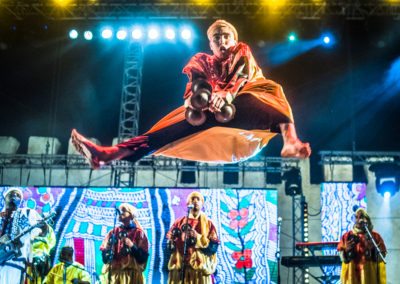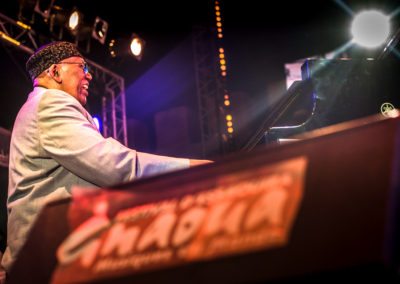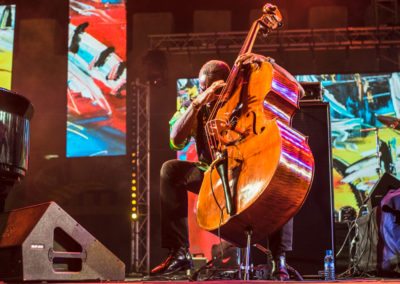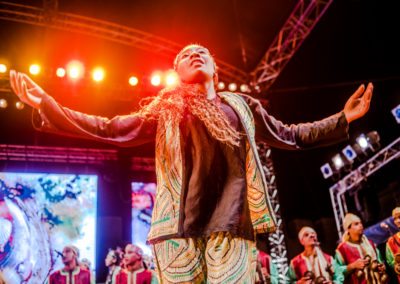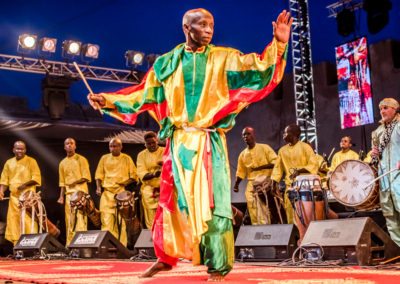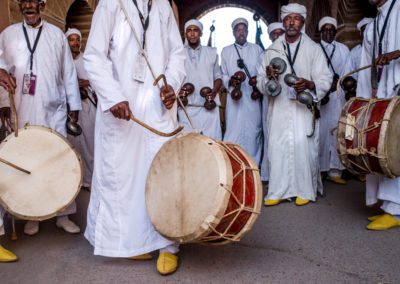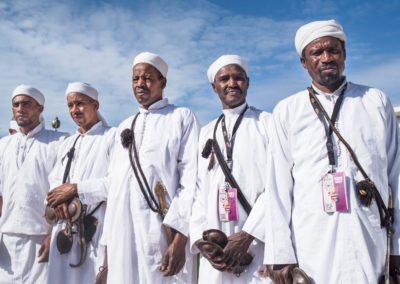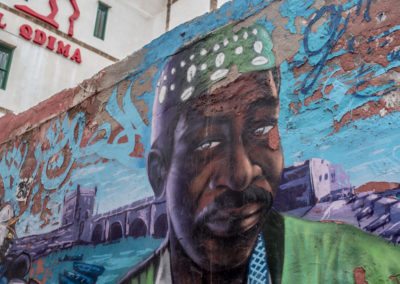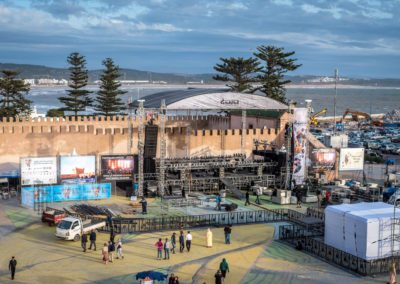Choosing between the sacred and the profane has always been problematic; making that choice at an African music festival is a particularly difficult decision.
The Gnaoua and World Music Festival at Essaouira, Morocco, is a unique opportunity to see and enjoy animist African culture embedded within an Islamic country. Gnaoua music is widely considered to have been introduced to Morocco from sub-saharan Africa when Sultan Moulay Ismail introduced thousands of slaves to form his Black Guard armies.
Gnawa music’s hypnotic, repetitive and drone-like tones induce trance states in ritualised ceremonies which can traditionally last through the night. Once in a trance people, through the ministrations of clairvoyants and the music played, can become possessed by and communicate with spirits which the Gnaoua believe exist around them at all times. Its sacred instruments are the gimbri, a three stringed lute constructed from a carved log whose strings are made from goat gut and percussive front from camel skin, together with oversized metal castanets called qraqabs and large drums.
Its most authentic sacred form is an all night long intimate ritualised ceremony called a lila. Here ancient, extended tunes and chants construct a musical pathway for people to welcome a spirit ( djinn) whilst in trance. Through the skills of the musicians, particularly the gimbri player, the spirit is mediated with and placated and the possessed person can then choose whether to live with that spirit or to exorcise it. This process is achieved entirely non-verbally through music and ecstatic dance. In order to perform this ritual the gimbri player must be considered a maâlem, a master musician and competent priest capable of conducting a complex ceremony lasting for many hours.
The powerful drone of Gnawa has successfully fused with western jazz, blues, hip-hop, pop and other styles. This fusion is celebrated on large stages around the city throughout the 3 day Festival and represents its profane form. Musicians and artists from both Morocco and other parts of Africa, as well as from America and Europe, play with Gnawa musicians.
The festival is held annually at Essaouira, a Moroccan city on its western Atlantic coast. It is a city recognised in the Arab world for having positive baraka ( spiritual energy ) due to its long associations with harmonious living between Jewish and Arabic residents. For centuries, due to economic advantages introduced by the Sultan Mohammed Ben Abdellah al-Khatib in the 18th century which encouraged trade and commerce, Essaouira had the largest percentage of resident Jews in the whole of Morocco. The city suffered culturally and economically following the exodus of Jewish people from 1948 onwards and today the mellah, old Jewish area, is extremely run down and few Jews now remain.
In 1997, the Moroccan government, in consultation with Andre Azoulay, its economic advisor and himself an inhabitant of Essaouira, decided to establish the Gnaoua Festival there.
Azoulay’s ambitions were not limited to simply creating a music festival driven purely by financial considerations. He has been described as an ‘agurram’; in arabic someone with a wide vision and energy and often capable of building intra-tribal and inter-tribal alliances. In 1976 he founded an organisation called Identité et Dialogue, described as ‘a group of Arab Jews who not only searched for their patrimonial roots and Judeo-Muslim understanding but were uncompromisingly dedicated to the idea of promoting an Israeli-Palestinian dialogue’. In creating the Gnawa festival Azoulay both indirectly replaced an ancient end of harvest mawsim (fair ) where music and poetry reading also occurred, he also consciously built on the historic Judeo-Arabic goodwill there. It has been claimed he, with the Moroccan government, has created a ‘haram’; an urban safe sanctuary for Jews, Christians and Muslims.
Gnaoua music’s original and authentic form is still retained locally in the form of private and ceremonial ceremonies. In Essaouira this tradition is dominated by the Guinea family where three brothers and a sister were born to maâlem Boubker Guinea and A’isha Qabral, a moqaddema (a kind of mystic diviner) famous throughout Morocco, and have all achieved considerable fame in the Gnaoua world. Brothers ( both maâlems ) Mahmoud and Abdullah have recently died and they are survived by a third brother maâlem Mokhtar, and a sister Ghania, who, like her mother, is a moqaddema. Mokhtar played on the main stage of this year’s festival whereas Ghania oversees the Zowiya Sidna Belal & Gnaoua d’Essaouira Mogador, the mystical institution dedicated locally to Gnaoua music.
Its profane form has succeeded in welding with other musical styles to become musical hybrids. Musicians from all over the world have been attracted to its hypnotic rhythms. These include Jimmy Page, Peter Gabriel, Carlos Santana, Randy Weston, Adam Rudolph, The Wailers, Pharaoh Sanders, Keziah Jones, Omar Sosa, Doudou N’diane Rose, Paolo Fresu. Randy Weston and Doudou N’diane Rose Percussian Orchestra re-appeared at the festival this year, together with Blitz the Ambassador, Christian Scott, Hasson Hackmoun, Jamaaladeen Tacuma and the Jeff Ballard Trio from the USA. Many other artists derive from Morocco itself and other African countries.
Over the three days of the festival concerts are held centrally on the Place Moulay Hasson stage, but also at venues on the beach and several historic locations in the city. Music can also be found around bars and cafes over the weekend; I was privileged to watch the free jazz bassist Jamaaladeen Tacoma play with local Guinea infants musicians at Cafe Salma in an impromptu gig at 2am. The cafe owner Ahmamou sells authentic Gnawa instruments.
Regarding its sacred form, the 2016 festival held three shortened lilas, each lasting for 3 hours, at several intimate spiritual locations around the city where people packed themselves into the colourful courtyards. The proceedings commenced with drummers and dancers setting the scene as a moqaddema ( female clairvoyant ) prepared incense to attract spirits. The djinn (in Arabic al-jinn) are spiritual beings mentioned in the Qu’ran who inhabit an unseen world. They are considered to be made of fire but they are able to interact physically with people and objects. Similar to humans, they can be good, bad or neutrally behaved. A system of 7 colours represent the nature of all spirits, and each colour has both its own symbolism as well as requiring a collection of different songs directed by the maâlem to communicate with that spirit. At each of the 3 lilas over the course of the festival people attending succumbed to the music, entered trance and approached the line of musicians to inhale more incense, dance ecstatically and accept possession by a spirit. Mediation with the spirit occurred through the skills of the maâlem gimbri player and his qraqab playing musicians.
The musicologist Deborah Kapchan explains that the history of the Gnaoua is largely oral; there are no writings or oral hagiography which has been passed on from generation to generation. She writes ‘The transmission of Gnaoua culture has been in the gestures, movements and attitudes of the body possessed. And in the musical and aesthetic repertoire of course. The history is in the songs – all 243 of them……By dancing to the spirits, moving to their dictates and rhythms history is embodied and made to live in the present.’
Although Gnaoua music is successfully becoming aligned with other music from around the world, it is clear that it also has a crucial role in maintaining the identity of a group of people whose ancestors were mostly removed by force from their sub-Saharan homes generations ago. Although integrated within the Islamic faith, the culture identifies exclusively with Bilal, Mohammed’s first black follower, but has no other written covenant or history on which to structure its values and traditions. It is a role that its music assumes exclusively.
The Gnaoua is spiritual music, sacred, but to succeed and thrive it must become increasingly profane. There-in lies its dilemma. I began this description with the statement ‘Choosing between the sacred and the profane has always been problematic’; this is a choice facing not only visitors attending the Gnaoua festival but more importantly one its artists and musicians also have to make in order to preserve the integrity and exclusivity of their culture and to move forward in a modern world.
References :
Deborah Kapchan Creating Musical History in Images http://www.umbc.edu/MA/index/number7/kapchan/kap_06.htm
Aomar Boum”Sacred Week”: Re-experiencing Jewish-Muslim Co-existence in Urban Moroccan Space. https://www.academia.edu/1803585/_Sacred_Week_Re-experiencing_Jewish-Muslim_Co-existence_in_Urban_Moroccan_Space
